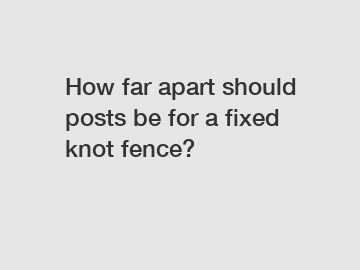How far apart should posts be for a fixed knot fence?
When it comes to installing a fixed knot fence, one crucial factor that must be carefully considered is the distance between each post. Proper spacing is essential to ensure the stability, durability, and effectiveness of the fence. In this article, we will delve into the ideal distance for post placement, discussing various considerations and factors that influence the spacing. By understanding these key factors, you can guarantee a robust and long-lasting fixed knot fence for your property.
Factors Influencing Post Spacing:
Factors such as the type of fence, geographic location, terrain, and intended purpose play a significant role in determining the optimal spacing between posts. Let's take a closer look at each of these factors:

1. Fence Type:
Fixed knot fences, which are commonly used for livestock and wildlife containment, are known for their strength and stability. To ensure the fence's structural integrity, the spacing between posts should align with the specific requirements of fixed knot fences.
2. Geographic Location:
Different geographical regions have varying weather conditions that can impact the stability of a fence. Windy areas, for example, require closer post spacing to mitigate the force exerted by wind on the fence. Conversely, areas with milder climates may allow for slightly wider post spacing.
3. Terrain:
The topography and slope of the land also influence post spacing. Steep or undulating landscapes require narrower spacing to maintain the fence's structural stability. In areas with level ground, slightly wider spacing may be acceptable, but care should still be taken to prevent sagging or collapsing.
Determining the Optimal Post Spacing:
Post spacing recommendations for fixed knot fences typically range between 8 and 16 feet, with the exact distance based on the factors mentioned earlier. However, following the average guidelines below can help achieve a sturdy and well-supported fence:
1. For level terrain and moderate wind conditions, a spacing of 12 to 16 feet between posts is generally suitable.
2. In regions with high winds, steep terrains, or heavy livestock pressure, narrower post spacing of 8 to 12 feet is advisable.
By adhering to these guidelines, you can ensure the fence maintains its integrity and effectively retains the animals it is designed to contain.
Conclusion:
The proper spacing between posts is crucial for the longevity and effectiveness of a fixed knot fence. Considering factors such as the fence type, geographic location, and terrain allows for a well-informed decision on post spacing. Remember, it is important to follow the manufacturer's recommendations, adapt to the specific requirements of your property, and consult professional fence installers for guidance.
Maintaining a robust fixed knot fence requires careful planning, expert installation, and attention to detail. By getting these factors right, you can enjoy a sturdy and reliable fencing solution for years to come.
For further assistance or to discuss your specific fencing needs, please do not hesitate to contact us.
Keywords: contact us.
For more PVC coated euro fence, Grating Fence, Huang Hua Garden Gateinformation, please contact us. We will provide professional answers.

Comments